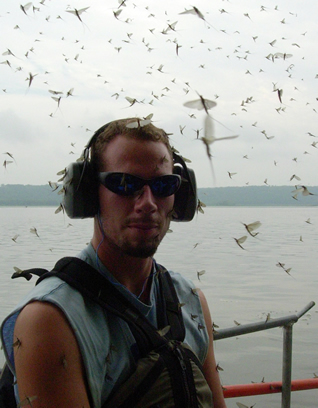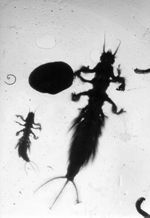|
- Macroinvertebrate (see photo-invertebrates visible to the naked
eye) monitoring by Wisconsin's LTRM Field Station consisted of
one episode of stratified random sampling in May or early June
to sample five target soft-substrate invertebrates (mayflies,
fingernail clams, midges, Asiatic clams and zebra mussels) with
ponar dredges from 1992-2004.
- One-hundred-twenty-five sites throughout Pool 8 were sampled
randomly.
- About 25 additional fixed historical sites were also sampled
each May; the exact number sampled depended on water level.
- Presence/absence data were noted on nontarget macroinvertebrates
incidentally recovered during sampling such as mollusks, mussels,
stone flies, dragon flies, caddis flies, scuds, oligochetes, and
others.
- Macroinvertebrate monitoring program wide was discontinued in 2005 due to budget reasons.
More specific information needed to interpret LTRM invertebrate
data can be found at the following link: (invertebrate
data format file.) Invertebrate data can be downloaded in text
format at this site as well (invertebrate
data browser).
|
Mayfly larva of the genus Hexagenia filter out tiny particles
of food for a year in U-shaped burrows they make in the mud
of the river bottom. In late June to early July, they emerge
as winged adults and fly in huge swarms to mate.
The adults are often attracted by lights on bridges or at
gas stations and can fly several miles inland, commonly creating
a slippery mess as they pile up and die on the pavement below
the lights. At times they have been so thick on bridges that
they had to be cleared with snowplows.
Mayflies are sensitive to gross organic pollution and their
presence is good news ecologically because it means that gross
organic pollution such as sewage is not present in large amounts.
Because they live in the sediment for most of their lives,
mayflies have also been extensively studied as potential accumulators
and indicators of trace contaminants such as heavy metals
and PCBs. |
|
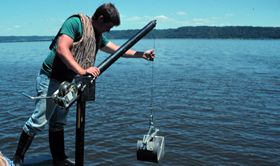
Invertebrate sampling in the LTRM involves lowering a ponar
dredge to the bottom of the river and scooping up the soft
bottom (usually sand, silt, clay, or a mixture). Sand, silt, and clay are then washed through a screen, leaving
the aquatic insects, clams, mussels, and snails behind on
the screen. These are identified. Target organisms (mayfly
larva, midge larva, fingernail clams, zebra mussels, and Asiatic
clams) are counted, and presence/absence is noted on the others.
The organisms screened are then returned to the river. |
|
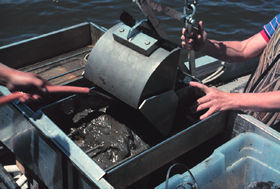
The jaws of the ponar dredge have been opened and mud grabbed
from the bottom of the river is being rinsed into a wash screen.
The mud will pass through the mesh of the wash screen, leaving
the inhabitants of the river bottom behind.
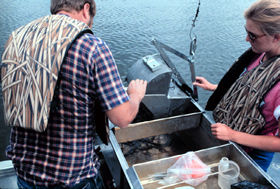
|
|
| Along with the 125 random sites stratified by type of aquatic
area, we also sampled 20-25 historical fixed sites that were
sampled prior to the beginning of the Long Term Monitoring element. Sedimentation in the backwaters, presumably due to
water flow dynamics involved with over 60 years of impoundment,
has filled in many of the historical sites to the extent that
it is difficult or impossible to navigate a boat to them.
Here, the La Crosse field station invertebrate sampling is
stalled when shallow waters make it impossible to motor to
a historical site and crew members must get out and push. |
 |
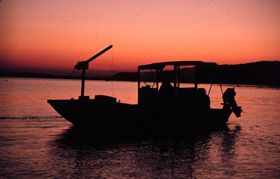
|
In autumn, LTRM field stations cooperate with state DNR
and USGS and US Fish and Wildlife staff to sample invertebrates
in areas where waterfowl are likely to congregate along the
upper Mississippi River. This helps them predict the food
supply and manage refuge areas closed to waterfowl hunting.
Jeff Janvrin of the Wisconsin DNR's Mississippi/Lower St.
Croix Team took this photo of the La Crosse Field Station's
boat rigged for invertebrate sampling in Pool 11, north of
Dubuque, Iowa during one of these fall sampling trips. |
La Crosse Field Station Team Leader
Telephone: (608) 781-6360
Fax: (608) 783-6066
|




